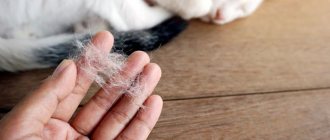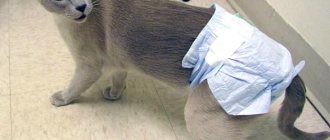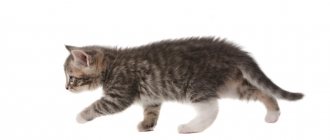When it is difficult for a cat to take a pill, an introducer will help. Thanks to the tool, there is no need to squeeze your fingers into your pet's mouth to place the medicine on the root of the tongue. Calm cats take medications normally. They adapt to evil animals so that the process is successful and without injury. A couple of simple steps will help. The instructions will tell you how to take the medicine correctly - whether the bitter tablet can be crushed or whether it needs to be consumed entirely.
Collecting information
If you are treating a pet and have been prescribed pills, I recommend that you immediately ask your veterinarian:
- is it possible to replace the medicine with a suspension or injections;
- Is it possible to crush the tablet and give it to the animal in powder form?
- Is it permissible to mix the medication with food?
The specialist will, of course, provide you with the necessary information. But you won’t run to the veterinary clinic for details if something suddenly doesn’t go according to plan. In any case, there are alternative options for taking the drug that are easier and less traumatic for both the cat and the owner. Let's look at and discuss them in detail.
Syringe manipulation
It often happens that a cat is cunning: it eats the food, but the tablet remains in the bowl. In these cases, you can dissolve the tablet in water and use a syringe to inject the medicine into your mouth. This is only suitable for drugs that are approved for mixing with liquid. In this case, you need to monitor the injection dose. It's better to limit yourself to a drop. After all, after strong pressure, the cat will have an aggressive reaction, and it will spend all its energy on escaping. Accordingly, some of the drug will spill, but it is unlikely to be able to calculate how much of the drug got inside. This method is not suitable for medicines with a bitter taste. Once inside, the tablets provoke salivation, which means that a certain part of the medicine will come back out.
If the cat does not eat dry food, you can do the same with liquid food. You should fill only part of the bowl, place the medicine there, watch how the cat empties the contents and then fill the bowl to the optimal level.
Give the tablet in solid form
Let's say the medicine must be given in solid form and cannot be crushed. For example, when it has a strong, repulsive taste, the tablet is coated with glaze. Arm yourself with patience right away. You must exude calm and confidence.
Animals feel slowness and fear, and if you get nervous, the pet will consider itself the master of the situation. I recommend purchasing an introducer in advance - the so-called pill dispenser. It will make the process much easier.
First way
- Prepare the necessary materials in advance: place a syringe without a needle filled with drinking water (5 cubes) and medications nearby.
- Take the animal in your arms or place it on the table. Pat it and let it calm down.
- Unclench your jaw with one hand, and with the other, place the tablet on the side of the tongue. Most likely, you will not be able to push it deep, so it is better to use an introducer.
- Close your mouth and don't let it open for a few seconds. Stroke the cat's chin from top to bottom. This stimulates the swallowing reflex.
- When the animal swallows, place a syringe behind its cheek and inject water. I recommend immediately getting more water, because at this stage the pet will resist, and the procedure will probably have to be repeated more than once.
Second way
It differs in that you will give the medicine together.
- Prepare for the procedure in accordance with the first two points of the previous method.
- One person should fix the animal in a comfortable position, take it by the scruff of the neck and tilt its head back.
- The other should open his mouth and push the tablet as far as possible, preferably placing it on the root of the tongue.
- Immediately introduce a small amount of water. The cat must swallow and swallow the medicine. Ready!
By the way, I found an interesting video where a veterinarian shows how to give a pill at home:
A must watch!
Using a blanket
The cat must be wrapped in a blanket, rug or large towel in order to prevent it from moving and to prevent it from being injured by its claws or bitten. Having wrapped your pet, you need to secure it: squeeze it between your legs, kneeling down. Place one hand on the animal's head so that the thumb and index finger are placed on the cat's cheekbones, closer to the mouth. When you press on the cheekbones, the mouth will open slightly and you can put the necessary medicine there.
Typically, drugs are available in liquid or solid form:
- When you use a liquid medicine that is in a syringe without a needle, then the mouth should be opened only a little so that the medicine does not spill out.
- If you need to give a pill to your pet, you will have to open its mouth wide. The medicine must be pushed deep into the mouth so that the cat cannot spit it out, and the animal must not be allowed to open its mouth until it swallows the tablet. If your pet holds the medicine in his mouth, you should blow a little into his nostrils, in this way you will trigger the swallowing reflex.
Give your cat something to drink after she swallows the tablet.
We give the tablet in powder form
If it is possible to crush the drug, the administration process will be easier. There are two options, depending on how the medicine is better absorbed - with or without food.
When can it be mixed with food?
Cats are sensitive to scents, so if the medicine has a strong smell, choose your pet's favorite food and mix the powder into it. For example, you can make mini meatballs the size of beans from fresh ground turkey and roll the powder inside.
Remember that raw pork and chicken should not be given to animals - this meat may contain eggs of intestinal parasites, as well as pathogenic bacteria such as salmonella. Read about what to feed your cat in a separate article.
The medicine can be mixed with sour cream and large strokes applied to the pet’s face. Considering cats' love of cleanliness, sour cream will most likely be quickly licked off along with the medicine.
When not to mix with food
If the powder cannot be mixed with food, check with your veterinarian to see if the drug can be given with water or milk. Most often this option is acceptable. Just make sure that the animal laps up all the liquid. And don’t expect the cat to do it on his own.
Slowly pour the solution from a syringe with the needle removed from the side of your mouth, directly under the root of your tongue. Fix the cat in the same way as described above in the case of a regular tablet.
Emotional mood
One of the mandatory conditions for treatment is to take care of the animal’s emotional state in advance. Before giving a pill to a kitten or adult pet, try to behave calmly and not be nervous. You can simply talk to the animal - the owner’s voice has a calming effect. It is not recommended to chase your pet throughout the apartment; it is better to wait until it comes on its own. It is prohibited to carry out the procedure near the sleeping area, tray or food bowl. Subsequently, the animal will associate them with unpleasant manipulations.
Another requirement is not to call the cat to take the medicine. The animal may decide that the owners are going to feed them, play or just pet them. In the future, the pets will refuse to respond to their owners’ calls.
You should not force an animal to take medicine, especially if a long course of treatment is prescribed. Each time it becomes more and more problematic to give a pill to a cat, so it is recommended to perform manipulations only on a pet that is in a state of calm. If your pet behaves aggressively or restlessly, it is better to postpone taking the drug for a while and repeat after an hour and a half.
X
How to protect yourself
Unfortunately, it is impossible to explain to the pet that the medicine is given for its benefit. To avoid bitten hands and a scratched face, take care of your safety in advance.
- Fix the animal in one position. Some breeds are characterized by increased aggressiveness or large size - for example, Bengal or Maine Coon. In this case, you need to do the procedures while standing, pressing the animal’s head against the thigh or a flat surface, for example, a wall. This fixation will protect you.
- Wear thick gloves - for example, fabric ones with rubber on top, so that it is not easy for the animal to bite through them. If you don't have gloves, use a thick piece of cloth.
- Some people advise swaddling the animal. This is indeed an effective method, but especially nimble cats can break out of the “cocoon” before you complete the procedure. Therefore, it is better to spend it together.
- The procedure should be quick, and your movements should be confident. Don't give in, cats feel everything.
Friends, I will be glad if you tell me how you treat your four-legged pets. The topic is as relevant and necessary as possible, so I collect such experience and gladly share mine!
Morally preparing the cat for the procedure
Preparation consists of securing the animal so that it does not injure you during the procedure. This can be done in different ways.
One option: wrap the cat in a blanket or thick blanket, similar to swaddling a baby. It is possible, especially if long-term treatment is required, to sew something like a cone from dense fabric with a hole in the upper part - only the animal’s head should fit through it.
Such a cone is put on a cat. Her paws are fixed inside, and her head remains free.
Another option: sit the cat on a soft pillow. In this case, you will have to hold the animal with your hands by the front legs. And the hind legs will “sink” into the pillow and the cat will not be able to scratch you with them.
The choice of how to restrict the animal's movements is up to you. The main thing is that it should not cause pain to your pet. It is better to give medicine together: alone you will not be able to handle both holding the cat and giving it medicine.
Precautionary measures
Real disaster can happen if you don't take precautions. Here are the basic safety rules you should follow:
- It is better to carry out the admission procedure together; call your loved ones or friends for help. One person will hold the purr, and the second will give the drug.
- Try to compress the entire process as much as possible in time. After all, the longer you torment your pet, the more aggression she will accumulate.
- We advise you to prepare the remedy away from the eyes of the purr, otherwise she will sense something is wrong and hide from you as far as possible.
- If you do the whole procedure alone, it is important to secure the paws with claws in a towel. This way, your pet will not have the opportunity to harm you.
What to do if it scratches and bites?
When your cat shows strong resistance, you cannot do without help. Ask someone close to you to hold your pet's paws.
If even these don’t help, then take a large towel and wrap the fluffy like a child.
It is important to leave only the muzzle, do not over-tighten it so that it does not choke him. If your pet is pregnant, then this option can be harmful, so you should avoid using a towel. Table comparing different methods
| pros | Minuses | Risks | |
| Stick it in your mouth | Fast way | May not swallow | May bite or scratch |
| Dissolve in water | No painful way | Not all tablets can be dissolved. time needs to be spent. | |
| Give via syringe | Quite a simple way | You must have a syringe on hand | May bite or scratch |
| Grind into powder | The easy way | If you add food, he may refuse and will not eat | |
| Add to food | The easy way | May refuse to eat | |
| Using a tablet dispenser | Must be purchased | May bite or scratch |
Puncture of the maxillary sinus
Practically not used in modern otorhinolaryngology. For acute bacterial sinusitis, systemic broad-spectrum antibacterial drugs are indicated, which successfully cope with the bacterial process without punctures and “cuckoos”.
Punctures for a bacterial process in the maxillary sinuses are mainly indicated if culture of the sinus contents is needed - usually when 1-2 courses of antibacterial therapy are ineffective.
Very rarely, such punctures are performed for diagnostic purposes, when it is not possible to perform radiography or computed tomography of the paranasal sinuses. Another indication is severe pain associated with the pressure of the contents on the walls of the sinus. The puncture is done once during the main treatment. Several punctures are indicated only in the case of a persistent bacterial process with two or more courses of antibiotics, and there is no possibility of performing endoscopic surgery on the sinuses.
It has been proven that puncture of the maxillary sinus does not speed up the healing process.
It is important to know : puncture, like any invasive method, can have complications, including trauma to the medial wall of the orbit, nasolacrimal duct, soft tissues of the cheek, and nosebleeds.
Endolaryngeal infusions
Recommended for acute laryngitis, along with nebulizers, mucolytics and much more.
The cause of acute laryngitis in most cases is a viral infection. Therefore, the main treatment here is time. The use of antibiotics is not indicated even for mild bacterial infections in the larynx, which are much less common than viral ones.
With endolaryngeal infusion, the solution enters directly onto the vocal folds at the time of phonation, which means there is a very high risk of it entering the lower respiratory tract. In cases where the larynx is poorly visible and the procedure technique is not followed, the doctor pours the solution into the esophagus, the patient swallows it, and there is no positive effect after the procedure, even temporary. At the same time, such a “blind” infusion of the solution increases the risk of aspiration (entry into the respiratory tract).
Antibiotics are used for infusions into the larynx, which, when applied topically, do not have a bactericidal effect. Oil solutions can be used, the positive effect of which is easily replaced by a home humidifier and ventilation. The effect of using hormonal agents (dexamethasone or hydrocortisone) is very short-lived. Moreover, in emergency situations, for example, for singers before a concert, preference should be given to the systemic use of hormonal therapy. The use of hormones leads to the rapid disappearance of inflammation of the vocal folds and improvement of voice quality, but one has to put up with the possible side effects of this group of drugs, so in standard situations the potential risk of their use outweighs the possible benefits.
A number of studies have shown that the voice is restored in equal time - when treated with antibiotics and when taking a placebo.
Important to know : viral laryngitis usually lasts 7-10 days and goes away on its own.
What the owner should remember
As we mentioned above, inserting a pill is almost always stressful for a cat. Introducing a dewormer once a quarter is not so bad, but what if the tablets need to be given daily, and even a couple of times a day? In order to minimize the animal’s unpleasant experience of treatment, the owner should remember the following:
Study these instructions and remove the tablet from the blister or bottle
(and also, if necessary, divide it into several parts)
is better outside the presence of a cat
. Animals are cunning creatures, and therefore they will probably rush to hide in a secluded place as soon as they realize from the crunch of a cardboard package or foil blister that the owner intends to give them a pill;
It's often the owners' fault that cats are afraid to take pills.
who are excessively nervous and noisy. There is no need to explain to the cat in a raised voice that the pill needs to be taken urgently, because the pet will still not understand why this procedure is needed. Under no circumstances should you hit a cat if it tries to escape. On the contrary, you should act as calmly as possible, talking to the animal in a quiet voice;
It happens that some cats are so intolerant of taking pills that they can easily injure the owner. In this case, it is advisable to call someone close to you for help.
. While the owner administers the medication, an assistant will hold the cat wrapped in a towel (or other cloth);
Even a calm and affectionate cat can bite its owner
when he gives her the pill. In such a case, it is better to prepare cotton wool and hydrogen peroxide in advance so that immediately after the bite you can treat the wound, first rinsing it with running water;
A cat that has taken a pill deserves praise and even a treat.
. Just don’t feed her a lot immediately after swallowing the medicine; it’s better to wait at least half an hour;
There are animals that never agree to swallow pills. They may drool and vomit profusely, hide under the bed, and even jump out of windows. If the situation with taking pills is so acute, it is better for the owner to consult a veterinarian about the form of the drug
. There are drugs that go on sale not only in the form of tablets, but also in the form of injections for administration (a subcutaneous or intramuscular injection can be given by the owner himself, and an intravenous injection must be given by a specialist), suspensions, sprays, suppositories, and powders. Perhaps the cat will easily swallow the drug in liquid form or will calmly tolerate the injection, so is it better not to torment it with tablets?
Gently bring the syringe to the corner of the animal's mouth
This technique will force the cat to spread its jaws. Hold the syringe so that the medicine is applied to the back of the tongue on the side, rather than directly into the throat, which may cause gagging.
It's worth noting that some veterinarians recommend allowing your cat to lick the tip of the syringe first so that the taste of the medication doesn't scare it off. If you are unsure about the correct technique, consult your veterinarian.











